The end of summer
This week: More stones; Fundamentals; Another insect; Being neighbourly;
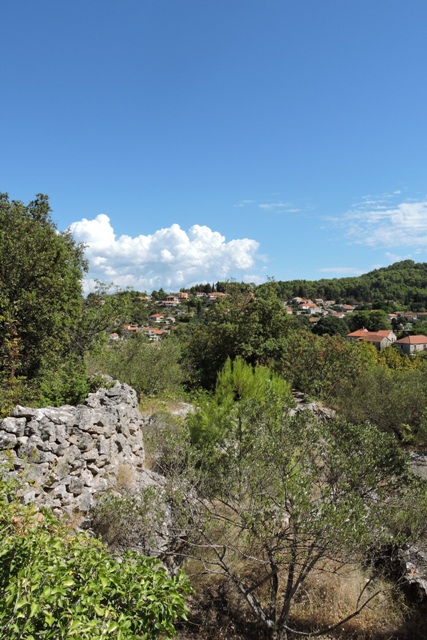
Almost the whole of my week this week has been spent in the orchard on projects relating to the Polytunnel.
It is all coming together, but like all successful projects, the foundation works take the greatest effort and longest amount of time.
The weather has been nice this week, warm autumn sunshine, but with some cloud. However we are still without any rain.
I am still irrigating plants, but now only every other day, because there is no moisture in the soil.
We would usually have expected to have had the first proper rain of the autumn/winter wet season. But there has been none.
It does mean it is nice to walk the lanes around Dol, but there is little to see beyond dry grasses and the odd dry thistle.
I’ve been on the lookout though for some of the autumn bulbs
The Yellow Autumn Crocus or Autumn Daffodil, Sternbergia lutea were in flower on Sunday morning.
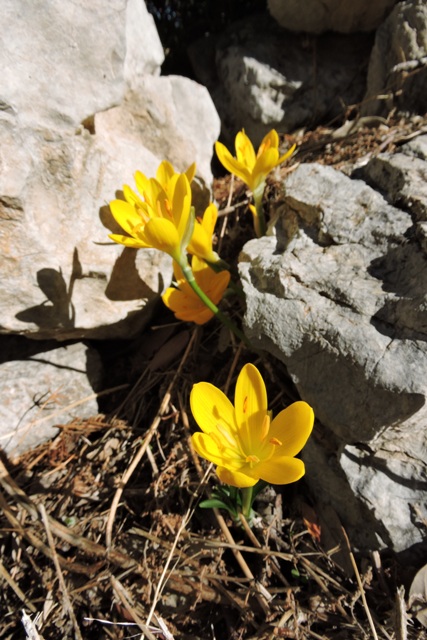
There are only three places I have seen them around Dol and these locations are well away from public view. I suspect they were once more numerous but the bulbs have been lifted and taken as they flower well into December.
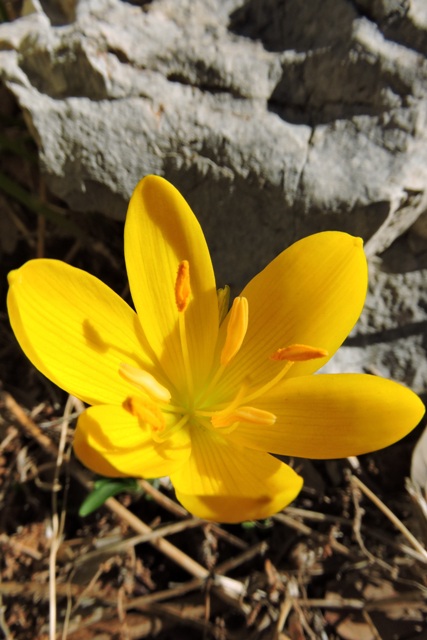
They are a rare protected plant in Croatia and should not be disturbed. However the fact that they are only to be seen well away from where people go and are not visible from any footpath is significant.
I put the photographs onto the Mediterranean Plants Facebook Group and they are also found in Crete, to the south of us, but few people have mentioned seeing them. That suggests to me that they are becoming more scarce.
Locally on the island only a couple of readers mentioned seeing them. This prompted me to reiterate part of the “Countryside Code”:
Only take photographs, only leave footprints…
More Stones
One thing I am definitely NOT short of is chunks of sandstone and limestone.
Sink a fork, or worse a spade, into any piece of bare earth and you will bring up small, medium of large pieces of stone.
I have said many times that by volume fully ⅓ of my soil is stone.
This week, doing things again the right way, I have laid a hardcore foundation under where the east end frame of the poly tunnel will go.
As I was working, once again I realised a couple of things.
There are a dozen very large and very heavy stones, that will be inside the tunnel unless moved first, and just outside, there are more “slightly less large” stones, just where I want to plant a pair of cherry trees.

So after laying the hardcore base, I started moving the inside stones first, on the principle that it will be a lot easier to do it now, than when I have the poly tunnel finished.
At the time I put them there, when I was dismantling the donkey stable, I had not had the idea to build a polytunnel and was just putting stones into heaps, based on their size.
These were the largest in size that I could move without assistance.
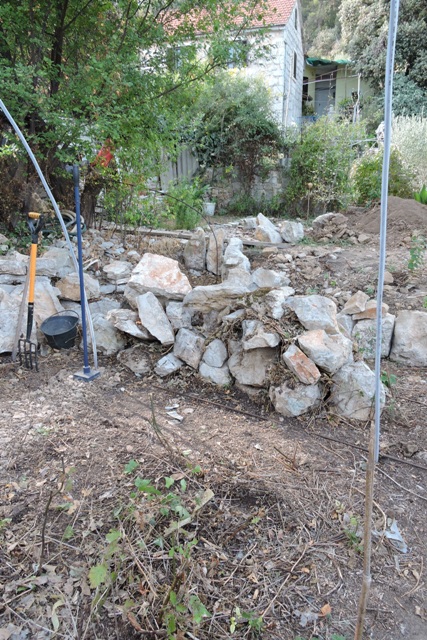
I moved them out of the way and then turned my attention to the pile on the right of the photograph.
It is actually a good time to move the stones because the garden reptiles are still very active in the warm sunshine.
A pair of Dalmatian Wall Lizards, Podarcis melisellensis fiumanus, the male with an orange throat and iridescent green back were sunbathing.
They are curious and kept coming out from under the stones as I carefully moved and lifted them.
This isn’t the nesting season. Rather they are eating spiders and snails to build fat before they hibernate. So moving stones now means they can find somewhere else before winter.
It has still taken me a couple of days to clear everything, but the area looks much better now.

Fundamentals
Everything takes time, especially when done properly.
I try only to do things once, however that often means that I over engineer things. I am safe in the knowledge that most of my work, I will never have to replace.
It is “only” a polytunnel, but I’m not planning on doing this again, so to make sure that the woodwork doesn’t rot, where wood touches the earth there will be good drainage.
Wood here tends to age. Seldom have I seen any rot and only where the wood is old, in a shady damp corner and in contact with the earth.
The end frames will be bolted to the stone wall to give structural strength, and on the ground I have put hardcore into a trench, followed by hard sand, all compacted before flat stones are laid.

I began laying the stones on which the wood frame will sit, bedding each one in before checking it for being level and then moving on.
I have a large flat stone to go under the door way. This will be where there will be pressure from the wheelbarrow wheel and general footfall.
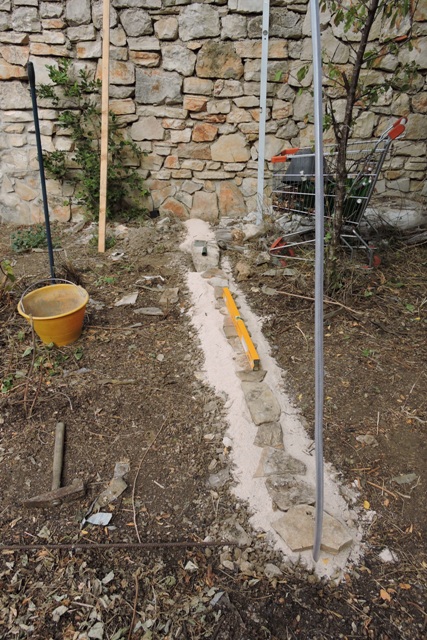
Then as Saturday lunchtime arrived, it was time to stop. I am happy with progress so far though.
Another insect
As I went to open the Utility Room door on Thursday morning, I saw I had a visitor on the door frame.
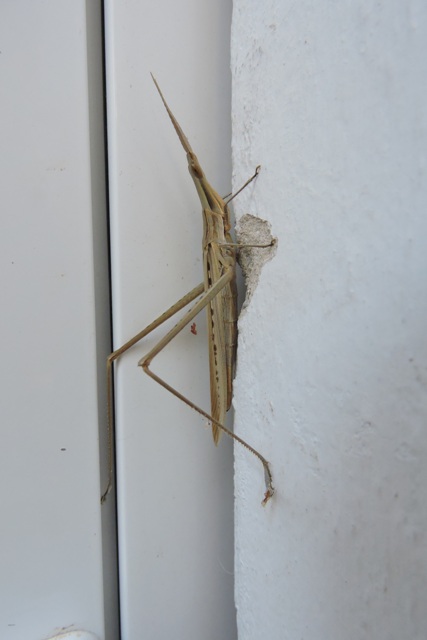
This is the Cone Headed Grasshopper, Acrida ungarica, a member of the of the family of grasshoppers, but one which is completely distinct.
I have seen them in the olive groves, where they like bare, open ground but with some dry grass where they can perch.
However although I have many different species of grasshopper in the garden, I have never seen one of these guys inside my boundary before.
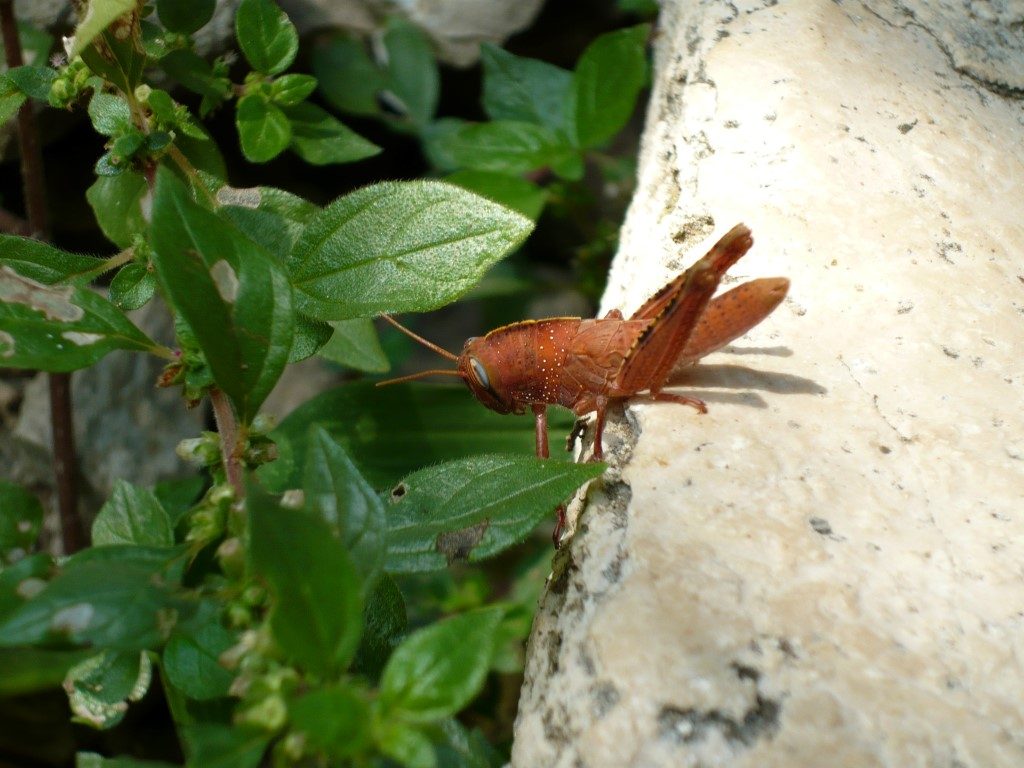

This thin, stick like species are adept at hiding in plain view but once seen, because of their up turned head, they are completely unique.
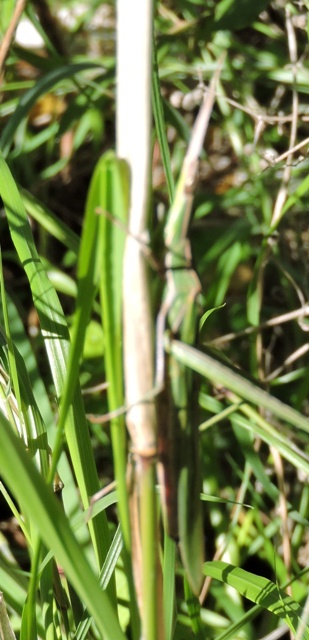
The adults appear late in the year, from August onwards and can still be seen until it turns cold at the end of November.
Being neighbourly
Around the world seasons are changing and blurring. As the sun rises at the moment, it catches the changing leaves of my Parthenocissus, the Virginia Creeper.
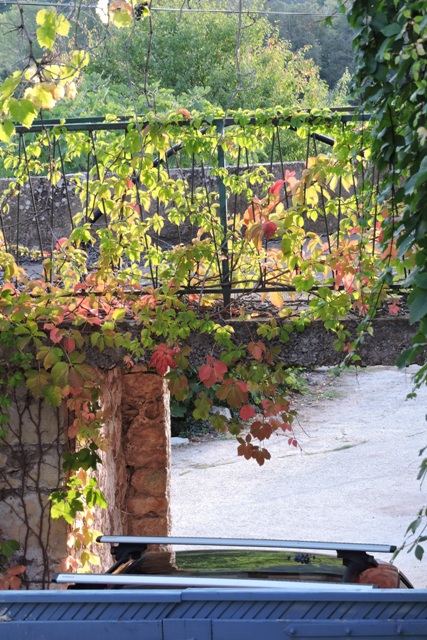
It is easy to tell locals from tourists here on the island at the moment. The tourists are still wearing shorts!
I’m still in a tee-shirt for the whole day, but the felines have all grown their winter coats and I notice they are spending the night indoors.
Some spend the day indoors too. Pongo is on my knee at the moment…
Although it isn’t warm enough yet for a fire, my neighbour asked me to help him split sections of tree trunk into logs for his fire.
He borrowed a diesel driven hydraulic log splitter and I spent the whole of Friday morning with him, reducing large dry rounds cut from a tree, which have been drying all summer.
This redwood is one of the Italian Cyprus which grow on the island. It is an oily wood, which gives off a lot of heat when burnt. It’s nice to be neighbourly….
There is a scientific description of the Mediterranean climate that can be summed up as “winter’s mild and wet, summer’s hot and dry”.
This conveniently ignores spring and autumn. Although to be fair, there is little clear dividing lines between the seasons.
Meteorologically speaking, the seasons begin on specific dates. Meteorologists and climatologists break the seasons down into groups of three months based on the annual temperature cycle as well as the Gregorian calendar.
In the Northern Hemisphere, for example,
Spring runs from March 1 to May 31;
Summer runs from June 1 to August 31;
Autumn runs from September 1 to November 30; and
Winter runs from December 1 to February 28 (February 29 in a leap year).
However this was based on the pre-climate change ‘climate’ of fifty or more years ago.
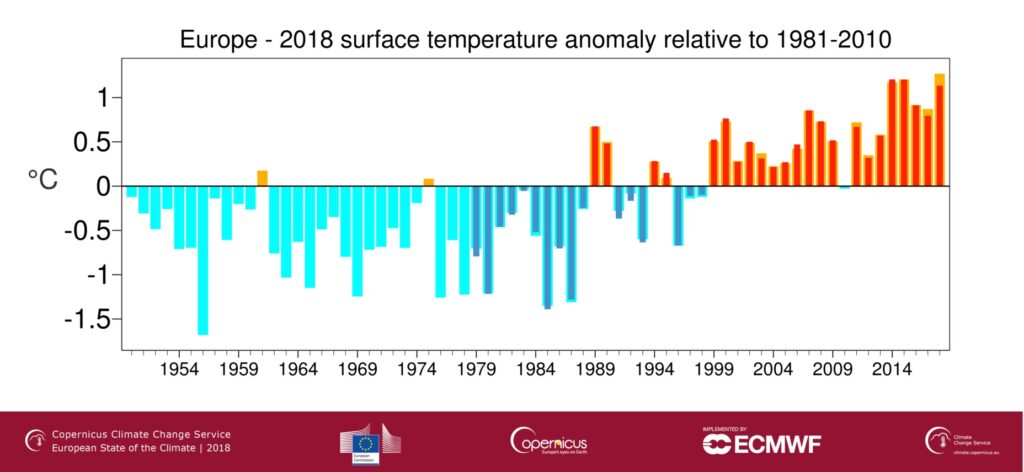
Here in Dol, winter is short, from mid December to mid January, by which time as the sun climbs higher in the sky, coupled with the warm surrounding sea, spring has begun.
Likewise, summer starts in early May and extends into September.
Although the documents are quite clear that the meteorological and climatology temperature changes are why the dates for the seasonal start have been chosen, I have been unable to find what those actual temperatures are.
I feel now that these fixed periods are out of date.
Just looking at my weather charts, if we say that summer is when the mean daily temperature is over 20ºC and Winter is when the mean temperature is less than 7.5ºC, we are talking about eighteen weeks of summer and five weeks between mid December and late January when it is winter.
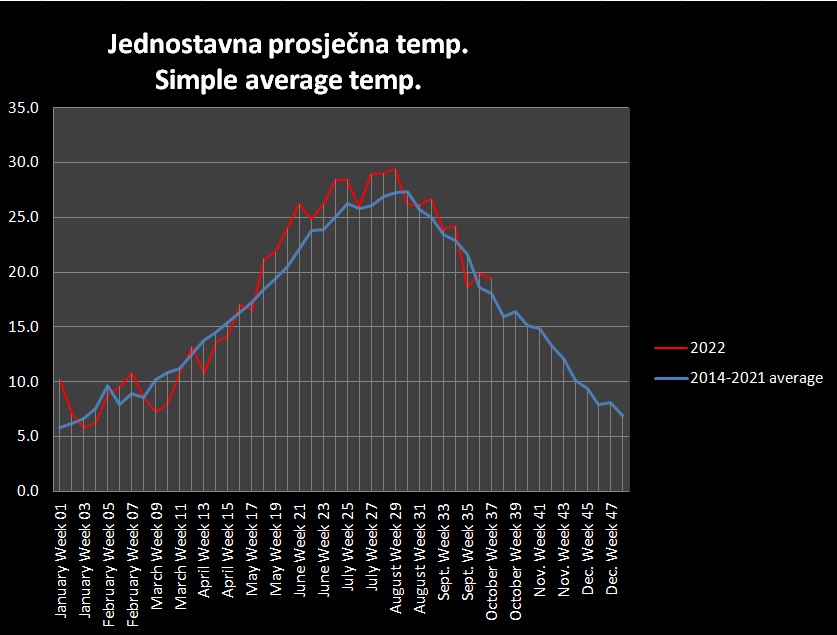
So we have reached the end of summer, but the good news for Dol is that it will soon be spring again……NCG
3 Responses
Tony Griggs
We are all experiencing La Niña here in Australia Norman. It’s been an unusually cold wet winter with a lot of rain through spring. The farmers are happy, they have a saying, “where there’s mud there’s money”! We are also experiencing more easterly winds than normal. Our tanks are overflowing and the weeds are growing profusely! Enjoy what’s left of yr autumn 😊
Andy
You are right about seasons not being fixed. Am sure you have noticed as I have.
Certainly not distinct changes as before.
A few years ago I would have a big coat on picking olives. Could be short sleeves again this year.
Marcy
Norman, the daffodil is stunning. I love the picture. And your garden and path are coming along nicely.
It’s going to be a wonderful hothouse for the plants. OK, I had no idea there were so many grasshopper species. The red one is stunning but I have to say the cone head isn’t my idea of a grasshopper. I wish I could say the same here for winter. It is very cool out but with the sun. It’s starting to get colder by the day. Soon the snow will be here and spring can’t come soon enough.
Thank you for sharing another beautiful day in Dol.